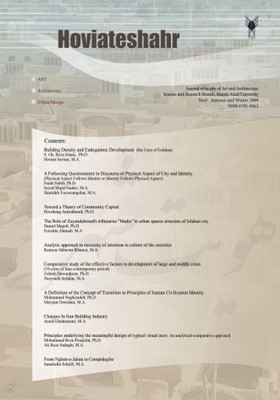به سوی نظریه سرمایه مجتمع زیستی
الموضوعات : architecture
1 - استاد برنامهریزی و توسعه منطقهای در دانشکده برنامهریزی و سیاست گذاری عمومی دانشگاه راتگرز، نیوجرسی، امریکا
الکلمات المفتاحية: فضای اجتماعی, Social Space, سرمایه مجتمع زیستی, رشد درون زا, جامعه فراگیر, Community Capital, Endogenous Gowth,
ملخص المقالة :
هدف از این مقاله معرفی مفهوم جدیدی در برنامه ریزی به نام "سرمایه مجتمع زیستی"1 است. به طور یقین در برنامه ریزی کمبود مفاهیم وجود ندارد. این مفاهیم که از ایده های متنوع نشأت می گیرند، دیدگاه های متفاوتی از برنامه ریزی ارائه می دهند. اهم آنها عبارتند از: 1- فرایند یا روشی برای رسیدن به وضعیت آینده مطلوب- اصطلاحاً نظریه های برنامه ریزی؛ 2- ایده هایی که برنامه ریزی را به عنوان مجموعه ای از نظریات محتوایی2 برای تشریح چگونگی پیدایش، تکامل، رشد، و افول جامعه انسانی مشاهده می کند- اصطلاحاً نظریه ها در برنامه ریزی؛ 3- ایده هایی که برنامه ریزی را به عنوان ابزار یا وسیله ای برای هدایت تغییرات به سوی یک هدف یا اهداف مشخص می بیند- اصطلاحاً نظریه ها برای برنامه ریزی. این مقاله با رویکردی تحلیلی به بررسی و تدقیق مفهوم نظریه سرمایه مجتمع زیستی، نقش، اهمیت و جایگاه آن در طرح ها و برنامه های شهری پرداخته است. به عبارت دیگر توجه را به سوی دارایی های مورد نیاز برای ساخت یک مجتمع زیستی موفق دعوت می کند.
1- Becattini G. (1990), “The Marshallian industrial district as a socio-economic notion” in Pyke F., Becattini G. and Sengenberger W. (eds.), Industrial Districts and Inter-firm
Cooperation in Italy, ILO, Geneva.
2- Benko, Georges, Dunford, Mick and Heurley, Jennifer (1997), “Les districts industriels, vingt ans de recherche”, in Espaces et Societes, No. 88/89.
3-Camagni R. (1991), “Local milieu, uncertainty and innovation networks: towards a
dynamic theory of economic space”, in R. Camagni (ed.), Innovation networks: spatial perspectives, Belhaven-Pinter, London.
4- Camagni R. (2002), “On the concept of territorial competitiveness: sound or misleading?” Urban Studies, n. 13.
5- Camagni R. (2004), “Uncertainty, social capital and community governance: the city as a
Milieu”, in R. Capello, P. Nijkamp (eds.), Urban dynamics and growth: advances in
urban economics, Amsterdam, Elsevier, 2004.
6- Camagni R., Villa Veronelli D. (2004), “Natural resources, know-how and territorial
innovation: the apple production system in Val di Non, Trentino”, in Camagni R., Maillat
D., Matteaccioli A.
7- Capello R. (2001), “Urban Innovation and Collective Learning: Theory and Evidence
from Five Metropolitan Cities in Europe”, in Fischer M.M. and J. Froehlich (eds.),
Knowledge, Complexity and Innovation Systems, Springer, Berlin, Heidelberg, New York.
8- Coleman J.S. (1990), Foundations of social theory, Harvard Univ. Press, Cambridge
Mass.
9- Dosi, G. (1982), “Technological paradigms and technological trajectories”, Research.
Policy, n. 3
10- European Commission (2005), Territorial state and perspectives of the European Union,
Scoping document and summary of political messages.
11- Grootaert C., van Bastelaer T. (2001), “Understanding and measuring social capital: a
synthesis of findings and recommendations from the social capital initiative”, World Bank, Social Capital Initiative Working Paper n. 24, April, Washington D.C.
12- Krugman, Paul (1993), Geography and Trade, MIT Press.
13- Lucas R. (1988), “On the mechanics of economic development”, Journal of Monetary
Economics, vol 22.
14- Malmgren H.B. (1961), Information expectation and the theory of the firm, Quarterly
Journal of Economics, 75.
15- Nelson, R., Winter, S. (1982), An evolutionary theory of economic change, Cambridge,
Mass., Harvard University Press.
16- North D. (1990), Institutions, institutional change and economic performance, Cambridge University Press, Cambridge.
17- Oates, Wallace E. (1972), Fiscal Federalism, Harcourt Brace Jovanovich.
18- OECD (1991). Strategic Industries in a Global Economy, OECD Publications, Paris.
19- OECD (2000), Cities and Regions in the New Learning Economy, OECD Publications, Paris.
20- OECD (2001), Why Territorial Politics Matter, Chapter I in OECD Territorial Outlook, OECD Publications, Paris.
21- OECD (2001), The Conceptual Framework, Chapter III in OECD Territorial Outlook, OECD Publications, Paris.
22- Porter, Michael E. (2000), “Clusters and the New Economics of Competition”, in Garten, Jeffrey E.: World Views, Harvard Business Review Books.
23- Putnam R. D. (1993), Making democracy work, Princeton University Press, Princeton.
Romer P. (1990), “Endogenous technological change”, Journal of Political Economy, vol.98.
24- Scott, Allen J. (1998), Regions and the World Economy, Oxford University Press.
25- Williamson O. (2002), “The lens of contract: private ordering”, American Economic
Review, Papers and Proceedings, vol. 92, 2, 438-453
_||_

